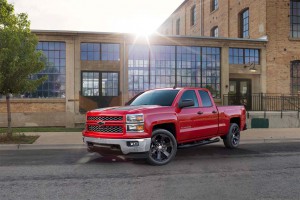
The popularity of new trucks, like the Silverado, due to lower gas prices kept the average fuel economy of new vehicles sold in October stagnant.
The layoff of more than 500 workers at two General Motors plants in Michigan highlights a big shift in demand, American motorists walking past the high-mileage small cars that topped the sales charts last year in favor of big, fuel thirsty pickups, SUVs and crossovers.
So, it may come as a surprise that the fuel economy of the typical vehicle sold in the U.S. last month didn’t take a big tumble, according to the University of Michigan Transportation Research Institute (UMTRI), and ran only slightly below the record levels set earlier in the year.
“The unchanged average fuel economy is likely a net consequence of two opposing trends—less demand for more fuel-efficient vehicles because of the decreasing price of gasoline, and improved fuel economy of 2015 model year vehicles compared to 2014 model year vehicles,” noted UMTRI researcher Michael Sivak who, with partner Brandon Schoettle, tracks the mileage of new cars, trucks and crossovers on a monthly basis.
The average fuel economy (window-sticker values) of cars, light trucks, vans and SUVs purchased in October was 25.3 mpg, the same as September, but down from 25.8 mpg in August. Vehicle fuel economy is up 5.2 mpg from October 2007, the first full month of monitoring by UMTRI.
The average price for a gallon of gasoline is now $2.923 cents per gallon, according to the AAA Daily Fuel Gage. Last month, Americans were paying $3.208 cents per gallon. With gasoline dropping below $3 per gallon in some parts of the country, Thomas King, J.D. Power vice president, also said the falling price of fuel has helped stabilize the sales of full-size trucks.
“As large pickup owners experience these low fuel prices each time they fill their tank, fewer of them are defecting from the segment,” he said. “While fuel prices are important, they are just one driver of consumer behavior, with factors such as incentives and product availability also influencing defection patterns.”
In GM’s case, the move by consumers to large trucks, crossovers and SUVS is crystal clear. The company’s full-size pickup line was up 13% in October while the Cadillac Escalade was up 18%, while Chevrolet Tahoe and Suburban retail sales up 18% and 9%, respectively. GMC Yukon and Yukon XL retail deliveries were up 49% and 51%, respectively. The Chevy Traverse was up 24% and its Buick cousin, the Enclave, was up 1.8%.
Other large vehicles also saw increases last month, including the Ford Expedition and Lincoln Navigator, which were up 18% and 38% respectively. Jeep saw its sales rise 52% in October and Ram pickups were up 33%.
(Glut of Saudi oil drives down gas prices. For more, Click Here.)
In addition to average fuel economy, Sivak and Schoettle issued a monthly update of their national Eco-Driving Index, which estimates the average monthly emissions generated by an individual U.S. driver. The EDI takes into account both the fuel used per distance driven and the amount of driving—the latter relying on data that are published with a two-month lag.
(Click Here for details on buyers gobbling up trucks and SUVs in October.)
The EDI improved for the fourth consecutive month in August to a record-low 0.76. The lower the index readings the better and they index currently shows emissions of greenhouse gases per driver of newly purchased vehicles are now down 24 percent, overall, since October 2007.
(To see more about Volkswagen’s new 10-speed transmission, Click Here.)
The price of petroleum, another factor in the overall calculation of fuel economy, has retreated from its previous highs. The price of oil futures, according to the federal Energy Information Administration, crept up slightly by 75 cents per barrel to $77.94 per barrel. But the price of oil futures is still more than $17 per barrel less than what they were a year ago.
At the same time, EIA reported that production of from the Bakken fields in North Dakota, a major factor in the increased production of oil in the Continental United States, is expected to exceed 1 million barrels per day during December.
